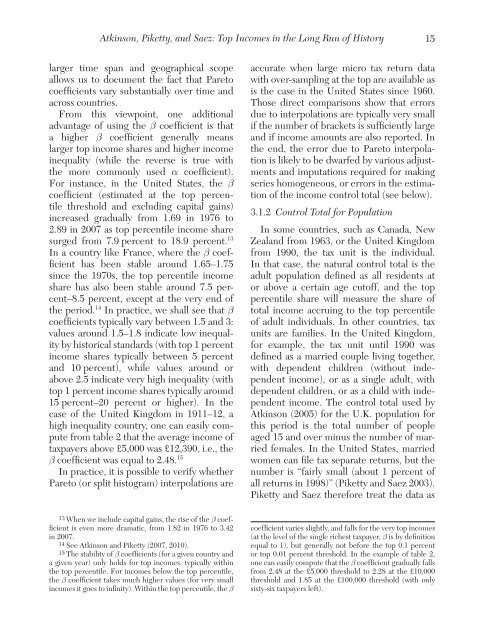"Top Incomes in the Long Run of History" with Tony Atkinson and
"Top Incomes in the Long Run of History" with Tony Atkinson and
"Top Incomes in the Long Run of History" with Tony Atkinson and
You also want an ePaper? Increase the reach of your titles
YUMPU automatically turns print PDFs into web optimized ePapers that Google loves.
Atk<strong>in</strong>son, Piketty, <strong>and</strong> Saez: <strong>Top</strong> <strong>Incomes</strong> <strong>in</strong> <strong>the</strong> <strong>Long</strong> <strong>Run</strong> <strong>of</strong> History15larger time span <strong>and</strong> geographical scopeallows us to document <strong>the</strong> fact that Paretocoefficients vary substantially over time <strong>and</strong>across countries.From this viewpo<strong>in</strong>t, one additionaladvantage <strong>of</strong> us<strong>in</strong>g <strong>the</strong> β coefficient is thata higher β coefficient generally meanslarger top <strong>in</strong>come shares <strong>and</strong> higher <strong>in</strong>come<strong>in</strong>equality (while <strong>the</strong> reverse is true <strong>with</strong><strong>the</strong> more commonly used α coefficient).For <strong>in</strong>stance, <strong>in</strong> <strong>the</strong> United States, <strong>the</strong> βcoefficient (estimated at <strong>the</strong> top percentilethreshold <strong>and</strong> exclud<strong>in</strong>g capital ga<strong>in</strong>s)<strong>in</strong>creased gradually from 1.69 <strong>in</strong> 1976 to2.89 <strong>in</strong> 2007 as top percentile <strong>in</strong>come sharesurged from 7.9 percent to 18.9 percent. 13In a country like France, where <strong>the</strong> β coefficienthas been stable around 1.65–1.75s<strong>in</strong>ce <strong>the</strong> 1970s, <strong>the</strong> top percentile <strong>in</strong>comeshare has also been stable around 7.5 percent–8.5percent, except at <strong>the</strong> very end <strong>of</strong><strong>the</strong> period. 14 In practice, we shall see that βcoefficients typically vary between 1.5 <strong>and</strong> 3:values around 1.5–1.8 <strong>in</strong>dicate low <strong>in</strong>equalityby historical st<strong>and</strong>ards (<strong>with</strong> top 1 percent<strong>in</strong>come shares typically between 5 percent<strong>and</strong> 10 percent), while values around orabove 2.5 <strong>in</strong>dicate very high <strong>in</strong>equality (<strong>with</strong>top 1 percent <strong>in</strong>come shares typically around15 percent–20 percent or higher). In <strong>the</strong>case <strong>of</strong> <strong>the</strong> United K<strong>in</strong>gdom <strong>in</strong> 1911–12, ahigh <strong>in</strong>equality country, one can easily computefrom table 2 that <strong>the</strong> average <strong>in</strong>come <strong>of</strong>taxpayers above £5,000 was £12,390, i.e., <strong>the</strong>β coefficient was equal to 2.48. 15In practice, it is possible to verify whe<strong>the</strong>rPareto (or split histogram) <strong>in</strong>terpolations areaccurate when large micro tax return data<strong>with</strong> over-sampl<strong>in</strong>g at <strong>the</strong> top are available asis <strong>the</strong> case <strong>in</strong> <strong>the</strong> United States s<strong>in</strong>ce 1960.Those direct comparisons show that errorsdue to <strong>in</strong>terpolations are typically very smallif <strong>the</strong> number <strong>of</strong> brackets is sufficiently large<strong>and</strong> if <strong>in</strong>come amounts are also reported. In<strong>the</strong> end, <strong>the</strong> error due to Pareto <strong>in</strong>terpolationis likely to be dwarfed by various adjustments<strong>and</strong> imputations required for mak<strong>in</strong>gseries homogeneous, or errors <strong>in</strong> <strong>the</strong> estimation<strong>of</strong> <strong>the</strong> <strong>in</strong>come control total (see below).3.1.2 Control Total for PopulationIn some countries, such as Canada, NewZeal<strong>and</strong> from 1963, or <strong>the</strong> United K<strong>in</strong>gdomfrom 1990, <strong>the</strong> tax unit is <strong>the</strong> <strong>in</strong>dividual.In that case, <strong>the</strong> natural control total is <strong>the</strong>adult population def<strong>in</strong>ed as all residents ator above a certa<strong>in</strong> age cut<strong>of</strong>f, <strong>and</strong> <strong>the</strong> toppercentile share will measure <strong>the</strong> share <strong>of</strong>total <strong>in</strong>come accru<strong>in</strong>g to <strong>the</strong> top percentile<strong>of</strong> adult <strong>in</strong>dividuals. In o<strong>the</strong>r countries, taxunits are families. In <strong>the</strong> United K<strong>in</strong>gdom,for example, <strong>the</strong> tax unit until 1990 wasdef<strong>in</strong>ed as a married couple liv<strong>in</strong>g toge<strong>the</strong>r,<strong>with</strong> dependent children (<strong>with</strong>out <strong>in</strong>dependent<strong>in</strong>come), or as a s<strong>in</strong>gle adult, <strong>with</strong>dependent children, or as a child <strong>with</strong> <strong>in</strong>dependent<strong>in</strong>come. The control total used byAtk<strong>in</strong>son (2005) for <strong>the</strong> U.K. population forthis period is <strong>the</strong> total number <strong>of</strong> peopleaged 15 <strong>and</strong> over m<strong>in</strong>us <strong>the</strong> number <strong>of</strong> marriedfemales. In <strong>the</strong> United States, marriedwomen can file tax separate returns, but <strong>the</strong>number is “fairly small (about 1 percent <strong>of</strong>all returns <strong>in</strong> 1998)” (Piketty <strong>and</strong> Saez 2003).Piketty <strong>and</strong> Saez <strong>the</strong>refore treat <strong>the</strong> data as13 When we <strong>in</strong>clude capital ga<strong>in</strong>s, <strong>the</strong> rise <strong>of</strong> <strong>the</strong> β coefficientis even more dramatic, from 1.82 <strong>in</strong> 1976 to 3.42<strong>in</strong> 2007.14 See Atk<strong>in</strong>son <strong>and</strong> Piketty (2007, 2010).15 The stability <strong>of</strong> β coefficients (for a given country <strong>and</strong>a given year) only holds for top <strong>in</strong>comes, typically <strong>with</strong><strong>in</strong><strong>the</strong> top percentile. For <strong>in</strong>comes below <strong>the</strong> top percentile,<strong>the</strong> β coefficient takes much higher values (for very small<strong>in</strong>comes it goes to <strong>in</strong>f<strong>in</strong>ity). With<strong>in</strong> <strong>the</strong> top percentile, <strong>the</strong> βcoefficient varies slightly, <strong>and</strong> falls for <strong>the</strong> very top <strong>in</strong>comes(at <strong>the</strong> level <strong>of</strong> <strong>the</strong> s<strong>in</strong>gle richest taxpayer, β is by def<strong>in</strong>itionequal to 1), but generally not before <strong>the</strong> top 0.1 percentor top 0.01 percent threshold. In <strong>the</strong> example <strong>of</strong> table 2,one can easily compute that <strong>the</strong> β coefficient gradually fallsfrom 2.48 at <strong>the</strong> £5,000 threshold to 2.28 at <strong>the</strong> £10,000threshold <strong>and</strong> 1.85 at <strong>the</strong> £100,000 threshold (<strong>with</strong> onlysixty-six taxpayers left).















